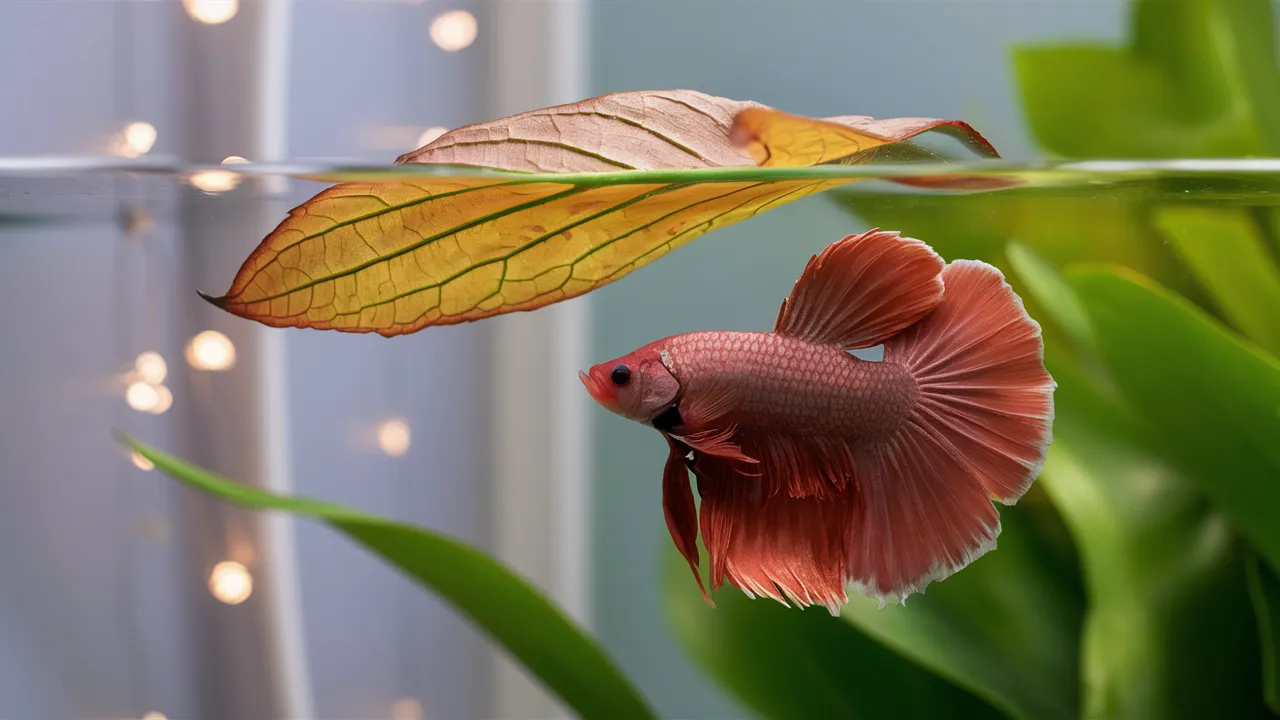Almond Leaf For Betta is a natural product derived from the Indian Almond tree. They have gained popularity among Betta fish enthusiasts for their numerous benefits.
This Betta Fish Guide will explore the various ways almond leaves can enhance the health and well-being of your beloved Betta fish, diving deep into their properties and how they contribute to a thriving aquatic ecosystem.
What Are Almond Leaves for Betta Fish?
Almond leaves, also known as Indian Almond leaves or Catappa leaves, come from the Terminalia catappa tree, native to tropical regions of Asia. These leaves have been used for centuries in traditional medicine and, more recently, in aquarium keeping. Their popularity in the aquarium hobby, especially for betta fish, has skyrocketed due to their numerous benefits.
The Natural Habitat Connection
Betta fish, scientifically known as Betta splendens, originate from the shallow, slow-moving waters of Southeast Asia. In their natural habitat, these waters are often stained brown by fallen leaves and other organic matter. Almond leaves mimic this environment, creating a more natural and comfortable setting for your betta.
Benefits of Almond Leaves for Betta Fish
- Water Conditioning
Almond leaves release tannins into the water, which naturally lower the pH and soften the water. This closely resembles the slightly acidic, soft water conditions that bettas prefer in their natural habitat.
- Stress Reduction
The dark, tea-colored water created by almond leaves can help reduce stress in betta fish. This dimmer environment makes them feel more secure, potentially reducing aggressive behavior and promoting overall well-being.
- Antibacterial and Antifungal Properties
Research has shown that almond leaves contain compounds with antibacterial and antifungal properties. A study published in the Journal of Applied Ichthyology found that these properties can help prevent and treat common betta ailments like fin rot and fungal infections.
- Breeding Aid
Almond leaves play a crucial role in betta breeding. They help stimulate spawning behavior and protect the eggs and fry from harmful bacteria. Many experienced breeders consider them essential for successful betta reproduction.
- Natural Food Source
As almond leaves decompose, they foster the growth of microorganisms like infusoria, which serve as a natural food source for betta fry.

How to Use Almond Leaves for Betta Fish?
Preparation
Before adding almond leaves to your betta’s tank, it’s essential to prepare them properly:
- Rinse the leaves thoroughly to remove any dust or debris.
- You can use the leaves whole or break them into smaller pieces, depending on your tank size.
- Some aquarists prefer to boil the leaves for a few minutes to speed up the release of tannins and sterilize them.
Application Methods
There are several ways to incorporate almond leaves into your betta’s habitat:
- Whole Leaf Method: Simply place a whole leaf in the tank. It will gradually release tannins and eventually sink.
- Tea Method: Create an “almond leaf tea” by steeping a leaf in dechlorinated water. Add this concentrated solution to your tank.
- Ground Leaf Method: Grind dried leaves into a powder and sprinkle it on the water surface or mix it into your betta’s food.
Dosage and Frequency
The general rule of thumb is to use one medium-sized leaf (about 7-10 cm long) per 10 gallons of water. However, this can vary depending on your specific goals and your betta’s response. Start with a lower dose and gradually increase as needed.
Frequently Asked Questions
1. Are almond leaves safe for betta fish?
Yes, almond leaves are generally safe for betta fish when used correctly. However, it’s important to monitor the water parameters closely and to avoid using too many leaves, as this can lead to excessively low pH levels.
2. How many almond leaves should I use in my tank?
The number of almond leaves needed will depend on the size of your tank and the desired tannin level. Start with a few leaves and gradually increase the quantity as needed.
3. How long do almond leaves last?
Almond leaves will gradually lose their effectiveness over time, typically lasting for 2-4 weeks. Replace them regularly to maintain the desired tannin level.
4. Can I use almond leaves with other aquarium plants?
Yes, almond leaves are compatible with most aquarium plants. However, it’s important to choose plants that are tolerant of slightly acidic water conditions.
5. Can I use almond leaves for other fish species?
While almond leaves are beneficial for betta fish, they can also be used for other fish species that prefer slightly acidic water conditions, such as tetras, Corydoras, and some types of shrimp.
Conclusion
Incorporating almond leaves into your betta’s habitat can significantly enhance their environment, closely mimicking their natural habitat and providing numerous health benefits. From water conditioning to stress reduction and disease prevention, these simple leaves pack a powerful punch in betta care.
Have you tried using almond leaves for your betta fish? We’d love to hear about your experiences! Share your thoughts in the comments below, and don’t forget to subscribe to our newsletter for more expert betta care tips and insights.

Related Posts
Culture Of Infusoria In The Tank: A Microscopic Feast for Fry
Clamped Fins On Betta: Causes & Treatment
Pregnant Betta Fish Giving Birth: Signs & How To Care